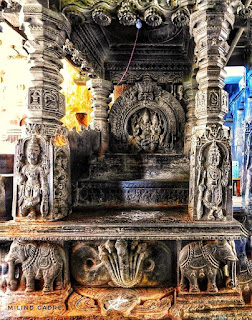Temple info -138 Madhukeswara temple. மதுகேஸ்வரர் கோயில்
Temple info -138
கோயில் தகவல் -138
The Madhukeshwara temple in Banavasi is dedicated to Lord Shiva gets its name from the honey-coloured Shiva Linga inside the sanctum. The temple dates back to the 4th century and hence it is one of Karnataka’s oldest temples.
According to a legend Madhu and Kaitabha, two demons, were killed by Vishnu on instance of Shiva. However, as both the demons were great devotees of Shiva, they both prayed vishnu to name two shiva lingas after their name, hence two lingas were consecrated after their names as Madhukeshvara and Kaitabheshvara. It is believed that an aspect of Shiva himself is enshrined in these lingas.
The one linga is the Madhukeshwara of Banavasi and the other one is Kaitabheshwara of Anavatti kotipura in Shimogga district.
Banavasi features in Hindu epics across many eras. It is referred to as ‘Vanavasika’ in the Mahabharata. Vanavasika, Jayanthipura, Konkanapura, Nandanavana, Kanakavathi, Jaladurga, Sanjayanti – over the centuries Banavasi has been called by numerous names, ruled by different dynasties, visited by acclaimed scholars and coveted by ambitious Kings.
The name ‘Banavasi’ comes from two words ‘Bana’ meaning forest and ‘Vasi’ meaning spring.
Banavasi was the first capital city of Karnataka when it was ruled by the first royal dynasty of Karnataka, Kadamba dynasty. The city dates back to 375 AD. when Kadamba's ruled over the ‘Kunthala’ region (containing present day’s Shimoga, Uttara Kannada and Dharwad disricts) from the early 4th Century to the 6th Century. Banavasi was then known by the name ‘Jayanthipura’ or ‘Vaijayanthipura’. As the most ancient city of India, perhaps next only to Varanasi, Banavasi has been a cultural and religious center for ages for all sects and creeds.
According to Mahavamsa, a Buddhist text, Samrat Ashoka had sent missionaries to Banavasi. Legends also say that Kalidasa too visited Banavasi as an ambassador of Gupta kings. His famous work Meghaduta has references to Banavasi.
Not only was it considered the first capital of Karnataka, it is also the birthplace for Kannada’s first poet, Adikavi Pampa (born 902 CE), who wrote his epic poems in Banavasi. “It is a virtue to be born in Banavasi as a human being. If not as a human being, then one should be born at least as a bee or a cuckoo in the garden of Banavasi” - Pampa
Madhukeshwara temple was first built by rulers of Kadamba dynasty. It was commissioned during the ruling period of the 1st King of the Kadambas Mayura Sharma in the 4th century.
After building the temple, it has undergone many additions, alterations and renovations in the later years by the later dynasties who occupied the seat of power of the area like Chalukyas, Hoysalas, Chutus, Vijayanagara Kings and Rulers of Sondha contributed their share from 4th century to 16th century.
Hence it is a mixed blend of various styles of architecture. Due to the passage of time, weather, neglect and vandalism it is not having the grandeur it had once. The temple is built in a vast area as was the custom of those days.
கலை நயம் கொண்ட பனவாசி ஸ்ரீ மதுகேஸ்வரர்!
கி.பி.345ம் ஆண்டுவாக்கில் பனவாசியில், கடம்பா வம்சத்தினரின் ஆட்சி துவங்கி, 200 ஆண்டு காலம் தொடர்ந்தது. இவர்கள் கர்நாடகம் முழுவதையும் தங்கள் ஆளுமைக்குள் கொண்டு வந்தனர்.
ராஜிராதா
முதன் முதலில் கன்னட மொழிக்கு முக்கியத்துவம் தந்ததுடன், காசுகளில் கன்னடத்தைப் புகுத்தியதும் இவர்கள்தான். 'ஆதி கவிபம்பா' என்ற முதல் கன்னடக் கவி வாழ்ந்ததும் பனவாசியில்தான்.
கடம்பா வம்சத்துக்குப் பிறகு, ராஷ்டிரகூடாஸ், கங்கா மற்றும் சாளுக்கிய வம்சத்தினர் எனப் பலரும் இப்பகுதியை ஆட்சி செய்ததுடன், கடம்பா மன்னரால் எழுப்பப்பட்ட ஸ்ரீ மதுகேஸ்வரர் திருக்கோயிலையும் புனரத்துவம் செய்தனர். கோயில் அமைந்த பகுதி காடு, மலைப் பிரதேசமானதால் கேரள பாணியில் அமைந்துள்ளது. இத்தலத்தில் கிருஷ்ணா நதியின் உப நதி பாய்கிறது. இயற்கை எழில் கொஞ்சும் இந்தக் கோயிலுக்கு ஏராளமான யாத்ரீகர்கள் வந்து செல்கின்றனர்!
துவஜஸ்தம்பத்தைத் தாண்டி கோயிலை அடைந்தால், இரண்டு அலங்கரிக்கப்பட்ட கல் யானைகளைக் காணலாம். அவற்றை நாள் முழுவதும் பார்த்துக் கொண்டேயிருக்கலாம் அவ்வளவு கலையழகு! தொடர்ந்து சென்றால் மிக நீண்ட மகாமண்டபம். இங்கேயும் ஏராளமான சிற்ப வேலைப்பாடுகள் அமையப்பெற்ற கலைப் பொக்கிஷங்களைக் கண்டு ரசிக்கலாம்.
முதலில் காண்பது நந்தி! எட்டடி உயரம் கொண்ட இந்த நந்தியின் கண்களை உற்று நோக்கினால், ஒரு கண் மூலவர் ஸ்ரீ மதுகேஸ்வரரை நோக்கியபடியும் மற்றொரு கண் அருகே தனிச் சன்னிதியில் காட்சி தரும் ஸ்ரீ மதுமதி (பார்வதி)யை நோக்கியபடியும் இருக்கும். நந்தியின் இரு கண்களும் இருவேறுபுறம் நோக்கினாலும், அதன் பார்வையை வழிநெடுகிலும் உள்ள தூண்கள் எதுவும் மறைப்பதில்லை. அந்தளவுக்கு தத்ரூபமாய் நந்தியை பிரதிஷ்டை செய்துள்ளனர். நந்தியின் கம்பீரத்துக்காகவே பார்த்துக் கொண்டேயிருக்கலாம்.
கோயிலின் விதானம், சுற்றுச்சுவர் என எங்கு பார்த்தாலும் செதுக்கப்பட்ட சிற்பக் கலைப் பொக் கிஷங்கள். ராஜாவின் சிம்மாசனம் போன்று வடித்து பார்வைக்கு வைக்கப்பட்டுள்ளது. கோயிலின் தூண்கள் கடைந்தெடுத்தவை போல் வழவழவென காட்சி தருகின்றன.
இவற்றைக் கடந்து சென்றால், கருவறையில் லிங்க சொரூபராய் ஸ்ரீ மதுகேஸ்வரரை தரிசிக்கலாம். தேனில் வடித்தெடுத்தது போல் ஜொலிக்கிறார் கருவறை மூலவர். இதனால்தான் அவருக்கு அந்தப் பெயராம். அதேபோல், அன்னை பார்வதிக்கு ‘மதுமதி' என திருநாமம்! மிகவும் எளிமையான கருவறையில் காண்பதற்கு இனிதாகக் காட்சி தருகின்றனர் அம்மையும் அப்பனும்.






Comments
Post a Comment